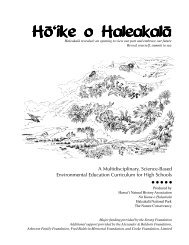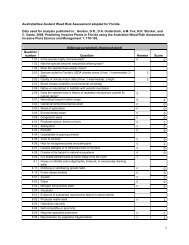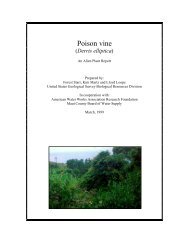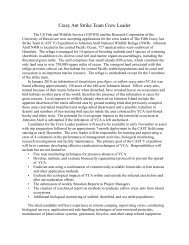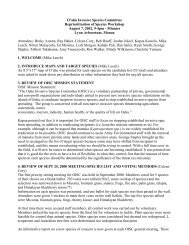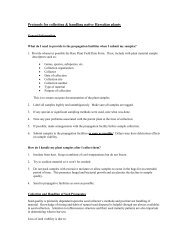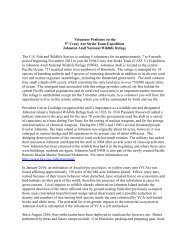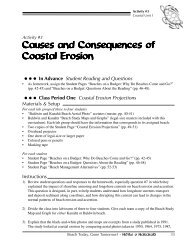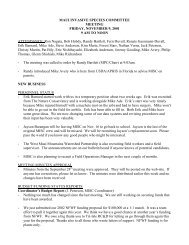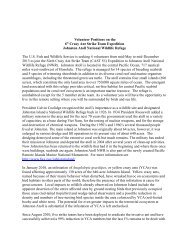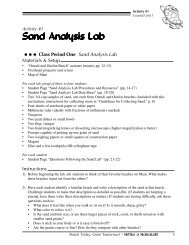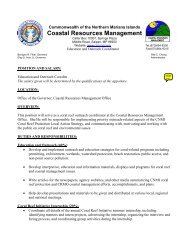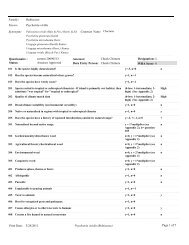Report to the Republic of Palau: 2008 update on Invasive Plant ...
Report to the Republic of Palau: 2008 update on Invasive Plant ...
Report to the Republic of Palau: 2008 update on Invasive Plant ...
You also want an ePaper? Increase the reach of your titles
YUMPU automatically turns print PDFs into web optimized ePapers that Google loves.
<str<strong>on</strong>g>the</str<strong>on</strong>g>re was <strong>on</strong>ce less <str<strong>on</strong>g>of</str<strong>on</strong>g> it, but this may just be because <str<strong>on</strong>g>the</str<strong>on</strong>g>re is now substantially more disturbed<br />
area that provides suitable habitat. In any case, whe<str<strong>on</strong>g>the</str<strong>on</strong>g>r native or not, it is certainly an<br />
aggressive vine, not <strong>on</strong>ly in <str<strong>on</strong>g>Palau</str<strong>on</strong>g> but also <strong>on</strong> o<str<strong>on</strong>g>the</str<strong>on</strong>g>r Pacific islands (<strong>on</strong> some <str<strong>on</strong>g>of</str<strong>on</strong>g> which it is known<br />
<str<strong>on</strong>g>to</str<strong>on</strong>g> be introduced).<br />
Operculina turpethum (<strong>on</strong>gucheta rekung), a native vine comm<strong>on</strong> throughout <str<strong>on</strong>g>the</str<strong>on</strong>g> Pacific,<br />
occupies a similar ecological niche as Merremia peltata, and is very prevalent in some locati<strong>on</strong>s<br />
where <str<strong>on</strong>g>the</str<strong>on</strong>g> latter species is absent, particularly <strong>on</strong> Peleliu.<br />
6. <strong>Invasive</strong> plant species not known <str<strong>on</strong>g>to</str<strong>on</strong>g> be in <str<strong>on</strong>g>Palau</str<strong>on</strong>g><br />
<str<strong>on</strong>g>Palau</str<strong>on</strong>g> is fortunate that a large number <str<strong>on</strong>g>of</str<strong>on</strong>g> troublesome species have yet <str<strong>on</strong>g>to</str<strong>on</strong>g> reach <str<strong>on</strong>g>the</str<strong>on</strong>g> country. The<br />
following list summarizes <str<strong>on</strong>g>the</str<strong>on</strong>g> worst <str<strong>on</strong>g>of</str<strong>on</strong>g> <str<strong>on</strong>g>the</str<strong>on</strong>g>se. These species should receive high priority for<br />
exclusi<strong>on</strong> from entry in<str<strong>on</strong>g>to</str<strong>on</strong>g> <str<strong>on</strong>g>the</str<strong>on</strong>g> country and promptly evaluated for eradicati<strong>on</strong> if found <str<strong>on</strong>g>to</str<strong>on</strong>g> be<br />
present.<br />
Several Acacia species are invasive <strong>on</strong> o<str<strong>on</strong>g>the</str<strong>on</strong>g>r Pacific islands, notably A. aulacocarpa (brown<br />
salwood, brush ir<strong>on</strong>bark wattle, hickory wattle), A. crassicarpa (nor<str<strong>on</strong>g>the</str<strong>on</strong>g>rn wattle, Papua New<br />
Guinea red wattle) and A. curassavica (redwood). A number <str<strong>on</strong>g>of</str<strong>on</strong>g> o<str<strong>on</strong>g>the</str<strong>on</strong>g>r Acacia species are<br />
recorded as invasive throughout <str<strong>on</strong>g>the</str<strong>on</strong>g> world, so cauti<strong>on</strong> should be exercised in planting members<br />
<str<strong>on</strong>g>of</str<strong>on</strong>g> this genus. Acacias are <str<strong>on</strong>g>of</str<strong>on</strong>g>ten introduced for forestry, wood supply or watershed protecti<strong>on</strong><br />
purposes.<br />
Albizia chinensis (Chinese albizia, silktree) is excepti<strong>on</strong>ally widespread in Samoa. Based <strong>on</strong> its<br />
behavior in Samoa, o<str<strong>on</strong>g>the</str<strong>on</strong>g>r Pacific islands should be very cautious about introducing this tree.<br />
Ardisia elliptica (shoebut<str<strong>on</strong>g>to</str<strong>on</strong>g>n ardisia) is a problem species in <str<strong>on</strong>g>the</str<strong>on</strong>g> Cook Islands, Hawai‘i, French<br />
Polynesia, Samoa and Florida (US). It produces prolific fruit and crowds out o<str<strong>on</strong>g>the</str<strong>on</strong>g>r species in <str<strong>on</strong>g>the</str<strong>on</strong>g><br />
forest unders<str<strong>on</strong>g>to</str<strong>on</strong>g>ry. Birds, which eat <str<strong>on</strong>g>the</str<strong>on</strong>g> fruit, are a major fac<str<strong>on</strong>g>to</str<strong>on</strong>g>r in its spread.<br />
Asystasia gangetica subsp. micrantha (Chinese violet, Philippine violet, coromandel) can grow<br />
over and smo<str<strong>on</strong>g>the</str<strong>on</strong>g>r o<str<strong>on</strong>g>the</str<strong>on</strong>g>r vegetati<strong>on</strong> and is a serious invader in Malaysia and Ind<strong>on</strong>esia. Small<br />
infestati<strong>on</strong>s are being eradicated in nor<str<strong>on</strong>g>the</str<strong>on</strong>g>rn New South Wales, Australia. It spreads by rhizomes<br />
and by seed expelled explosively from capsules and would be a serious weed in <str<strong>on</strong>g>Palau</str<strong>on</strong>g>. The less<br />
invasive subsp. gangetica was seen in cultivati<strong>on</strong> in Koror State and <strong>on</strong> Babeldaob,<br />
Two rubber trees, Castilla elastica (Panama rubber tree) and Funtumia elastica (African rubber<br />
tree), are very invasive in Samoa. Birds spread <str<strong>on</strong>g>the</str<strong>on</strong>g> seeds <str<strong>on</strong>g>of</str<strong>on</strong>g> Castilla while those <str<strong>on</strong>g>of</str<strong>on</strong>g> Funtumia are<br />
wind-borne “parachute” seeds.<br />
Cardiospermum grandiflorum (ballo<strong>on</strong> vine; heart seed) is very invasive <strong>on</strong> Raro<str<strong>on</strong>g>to</str<strong>on</strong>g>nga, Cook<br />
Islands, and is reported <str<strong>on</strong>g>to</str<strong>on</strong>g> be invasive in Australia as well.<br />
Cecropia obtusifolia (trumpet tree, guarumo) is an invasive tree species that is a problem in<br />
Hawai‘i and <str<strong>on</strong>g>the</str<strong>on</strong>g> Cook Islands (Raro<str<strong>on</strong>g>to</str<strong>on</strong>g>nga). Cecropia peltata (trumpet tree), a similar species, is<br />
invasive in French Polynesia.<br />
22



